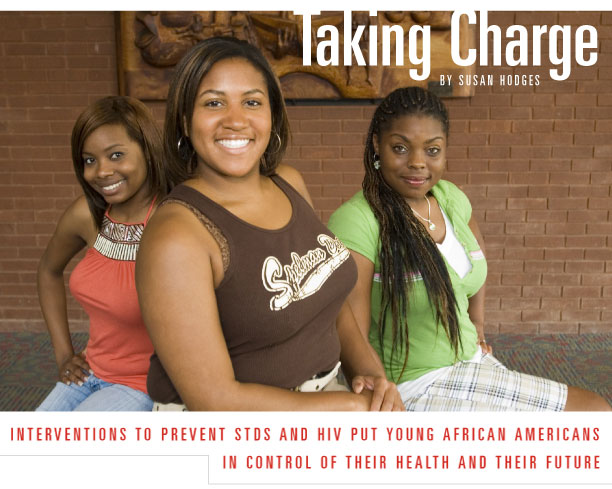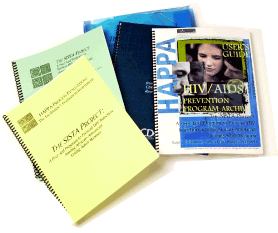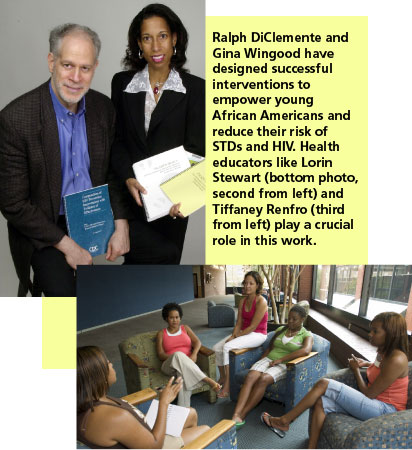














|
 |
| |
|
|
| |
Thanks
to the Horizons program, Gimel Rogers, pictured (center), doesn't
hesitate to talk about STD and HIV prevention with friends Ericka
Thomas (left) and Brittany Collins. |
|
| |
|
|
| |
 E-mail
to a Friend
E-mail
to a Friend  Printer
Friendly Printer
Friendly |
|
| |
|
|
| |
"I'm
14, my boyfriend is 16. He won't use condoms—he said
it would be OK. I just want to be with him. Now I'm pregnant,
and I just found out I'm HIV positive. My life is a mess.
How did this happen?" |
|
| |
|
|
| |
Twenty-five
years into the AIDS epidemic, teens have become silent victims of
sexually transmitted diseases (STDs) and HIV. Uninformed, misinformed,
and not knowing whom to talk to, they stumble through adolescence,
with consequences that can last a lifetime.
The statistics paint a grim picture.
Though young people ages 15 to 24 constitute only a quarter of the
sexually active U.S. population, they account for nearly half of
all new STD cases, as well as half of new HIV infections. By age
25, one of two sexually active youths will acquire an STD. The lifetime
medical costs of STDs acquired by American youth ages 15 to 24 in
the year 2000 was at least $6.5 billion. |
|
| |
|
|
| |
REVERSING
THE DIRECTION |
|
| |
African
American female adolescents are especially vulnerable to HIV and
STDs, thus making tailored interventions a public health priority.
The challenge is to get teens to recognize that they are at risk.
"I want to make sure that our
young women are empowered to know the effects of HIV and that it's
preventable," says Tiffaney Renfro, a lead health educator
for AFIYA, an HIV prevention program for adolescent African American
females run through the Rollins School of Public Health (RSPH).
"AFIYA is about enabling young
women to emerge into strength and good health, to feel pride as
black women, and to identify role models. We talk about their future
plans and get them to explore ways to make better decisions regarding
their sexual health. It's all about choices," Renfro adds.
"I learned a lot," says
Gimel Rogers, a Spelman College sophomore who went through Horizons,
a program similar to AFIYA, when she was 17. As for sex, she learned
"to be safe through abstinence and through sex, to be safe
with it. Now, when they show commercials on TV about HPV [human papillomavirus], I talk to my friends and educate them about it."
papillomavirus], I talk to my friends and educate them about it."
Thanks to Horizons, Rogers began to
set goals to empower herself and chart a positive course for her
life. That skill led her to apply to Spelman, the first step toward
earning a doctorate in child psychology. She still has her list
of goals from when she went through the program. "It holds
even more value now," Rogers says.
Girls ages 14 to 20 in the AFIYA treatment
group are involved in similar activities. They participate in a
face-to-face intervention, followed by one-on-one telephone counseling
nine times in 18 months and access to a website where they can learn
various coping skills: how to talk to their partner about STDs,
how to use a condom, resources for HIV testing, approved websites
tailored for teens, and current events and outings that help promote
safer sex options.
The two researchers who designed the
AFIYA intervention and its predecessor programs are Ralph DiClemente
and Gina Wingood. They met in San Francisco at the Bayview-Hunter
Point Foundation Multicultural Research Institute in the early 1990s,
and with a common interest in HIV prevention, have been working
together ever since.
"In AFIYA, with both the face-to-face
intervention and one-on-one phone counseling, we're seeing 50% reductions
in STDs," says DiClemente. "If you could expand that,
you would reduce the number of STDs by more than 6 million nationally."
DiClemente has come a long way since
his 1986 article in the American Journal of Public Health
alerted AIDS researchers to the risk of HIV for adolescents. He
is the Charles Howard Candler Professor of Public Health in the
Department of Behavioral Sciences and Health Education, where Wingood
is associate professor and recipient of the Agnes Moore Research
in AIDS Endowment. Additionally, Wingood is director and DiClemente
is associate director of prevention science in the Social and Behavioral
Sciences Core of the Emory Center for AIDS Research. |
|
| |
|
|
| |
EARLIER
SUCCESS |
|
| |
In
San Francisco, the two conducted a study called SISTA (Sisters Informing
Sisters about Topics on AIDS), designed to address the growing number
of African American females at risk for HIV and STDs. The study
applied social cognitive theory and the theory of gender and power
to a culturally tailored, gender-tailored intervention for African
American women ages 18 to 29. A 1995 article in the Journal
of the American Medical Association (JAMA) reported that after
the SISTA intervention, women used condoms more consistently, displayed
stronger interpersonal skills, and exhibited better cognitive coping
skills. Adopted and disseminated by the CDC, SISTA is requested
by more people than any other CDC program, DiClemente says. Wingood
adds that over 700 U.S. community agency educators have been trained
to implement SISTA, at least one in every state.
In the early 1990s at the University
of Alabama's Center for AIDS Research in Birmingham, DiClemente
and Wingood built upon the SISTA program with an intervention called
SiHLE, a Zulu word that means beauty and stands for Sistas Informing,
Healing, Living, and Empowering. This program aimed to reduce sexual
risk for African American females ages 14 to 18.
The four-hour SiHLE sessions were
held on four consecutive Saturdays and involved African American
females as health educators and as peer educators. The theme, "Stay
Safe for Yourself, Your Family, and Your Community," helped
the young women who received the intervention learn to value themselves
and realize their value to both family and community. SiHLE focused
on teaching them to communicate with their often older male partners,
since successful sexual risk avoidance requires that the female
negotiate with the male to use condoms or to practice abstinence.
Peer educators modeled desired behaviors, and participants role-played
to enhance adoption of the behaviors.
Close bonds are struck among SiHLE
participants. "We hope this forms a peer social network of
like-minded women who are supportive of safer sex activities,"
Wingood says. When moms see the program's benefits, they often
ask if their younger daughters can participate. "They want
their daughters' lives to be better than theirs," DiClemente
says.
A July 2004 issue of JAMA
reported that during and at the end of the 12-month SiHLE study,
participants were more likely to report using a condom consistently,
and they reported fewer chlamydia infections and fewer pregnancies.
SiHLE is the first HIV/STD intervention to reduce risk behaviors
and increase HIV preventive behaviors and also decrease STDs and
unintended pregnancy. These results were confirmed again at an 18-month
follow-up.
"SiHLE received the highest
rating of any HIV prevention intervention for adolescents in this
country ever," DiClemente says, referring to independent panel
ratings at CDC and the research firm Sociometrics. Wingood says
that SISTA, SiHLE, and WILLOW, a program for HIV-positive women,
will be disseminated nationally to community-based organizations
and health departments as a triad through the CDC's Diffusion
of Effective Behavioral Interventions project. The team's
current programs are designed to be included with these in a larger
suite of sexual risk-reduction programs. Using common theories,
the programs focus on enhancing gender and ethnic pride, self-worth,
and altruism, imparting knowledge and skills, and changing attitudes,
perceptions, and values.
In the June 2006 American Journal
of Public Health, Wingood reported that the SiHLE intervention
was as effective for girls who reported a history of gender-based
violence as for those who did not. SiHLE was also successful for
girls who reported depression, a finding that DiClemente presented
at the 2006 International AIDS Conference in August. "The
SiHLE program is robust, more so than we would have imagined. We
can't work fast enough to disseminate it," he says.
|
|
| |
|
|
| |
 |
|
| |
|
|
| |
TEENS,
WOMEN, AND COUPLES |
|
| |
DiClemente
and Wingood have a number of other intervention studies under way,
designed for teens, women, and couples. T3, Tracking Teen Trends:
Adolescents, Sex, and the Web, looks at adolescents' exposure
to the Internet. Every year, about 60% of 15- to 17-year-olds wind
up at a sexually explicit website. This national study hopes to
determine the impact of these sites on the beliefs, values, attitudes,
and behavior of this group of teens. Results should be available
by spring of 2007.
STYLE, an STD/HIV prevention program
for young people who have an emotional disorder, tests whether involving
parents is more effective than just kids. "We train parents
and adolescents to raise sensitive issues and problem-solve without
becoming frustrated and angry," DiClemente says.
For many community agencies, an interactive
DVD is a more cost-effective choice than face-to-face programs.
Wingood's program, SAHARA (Sistas Accessing HIV/AIDS Resources
At a click), uses a DVD to reach more women with the hope of reducing
their risk behaviors while using fewer resources.
She also spearheads an HIV prevention
program for female Kaiser HMO patients, ages 18 to 29, called STARS.
"It's a myth to think that if you're working and
you have a college education you're not at risk for HIV,"
Wingood says. After an eight-hour HIV education session, participants
may be randomized to receive a booster session at six and again
at nine months. The question Wingood seeks to answer is, do women
have safer sex, get HIV tested, and have fewer sexually transmitted
infections if they have boosters than if they do not?
A multisite study called EBAN addresses
the risks African American couples face when one partner is HIV-positive
and the other is not. For some serodiscordant couples, using a condom
erodes trust; some aren't afraid to get HIV. The importance
of this study becomes clear when Wingood points out that a positive
partner could acquire a different strain of HIV and make their health
much worse. |
|
| |
|
|
 |
| |
|
|
| |
AROUND
THE WORLD |
|
| |
Wingood
also adapted SISTA for Xhosa women in rural Cape Town, South Africa.
"There are very few interventions for women in sub-Saharan
South Africa, who are at great, great risk of HIV. We have a program
in Durban as well, for adolescents ages 16 to 21," she says.
UNAIDS statistics support the need: sub-Saharan Africa carries the
largest burden of the AIDS epidemic. Here, on average, three young
women ages 15 to 24 are HIV-infected for every one young man. In
the same age group, high levels of HIV infection found in a 2003
national survey remained high two years later.
The Caribbean is the second-most HIV-affected
world region. SiHLE was adapted for young women ages 14 to 18 on
St. Maarten, a multicultural island, where the program's name
was changed to Girl Power. The island's governor decided to
adopt the program in schools and to request a program for boys.
"That's the power of taking research and putting it
into action," DiClemente says. |
|
| |
|
|
| |
WHAT'S
NEXT |
|
| |
The
Structural HIV Prevention Intervention looks at the power of media
in the lives of African American teens ages 14 to 18. "Many
people think that media is harmful to adolescents. We think that
we can use media to promote health among them," DiClemente
says. Four cities are paired according to like demographics, and
one in each pair will receive media messages in addition to an intervention
like SiHLE. Messages will be divided half and half on radio and
TV, including prime time shows like American Idol and Girlfriends.
"What do adolescents love more than TV and radio? If we can
reach them this way, we'll reach thousands upon thousands
of adolescents," DiClemente says.
Wingood and DiClemente plan an interactive
computer delivery intervention, a national survey of African American
and white women that will uncover risk factors, and more work with
social groups. "Faith-based organizations are one of the largest
social organizations in Georgia. Working with churches is our next
direction and goal," Wingood says.
This team's recipe for success: determine what makes women
and teens vulnerable to STDs and HIV, and then inspire motivation
and teach healthy behaviors. When the intervention works, get it
out into the community, and follow up by tailoring effective programs
to other vulnerable populations.
"The challenge is always to
increase awareness among adults, including politicians and policymakers,
that young people are engaging in risk behaviors and we can't
deny them the knowledge, tools, and skills they need to minimize
their risk," DiClemente says.
The possibilities for turning lives
around seem endless. As long as the need exists, DiClemente, Wingood,
and their staff will continue to stir up the Girl Power and spread
it around.
Susan
Hodges is a freelance writer in Atlanta. |
|
| |
|
|
|
|
|
|



